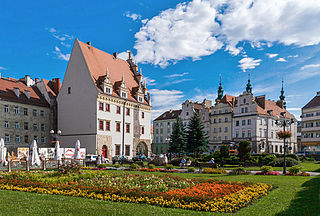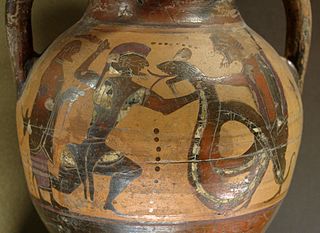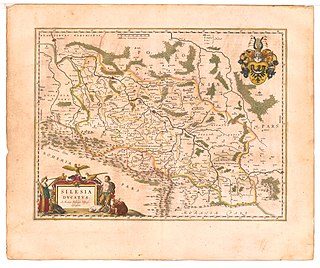Related Research Articles

Nysa(listen) is a town in southwestern Poland on the Eastern Neisse river, situated in the Opole Voivodeship. With 43,849 inhabitants (2019), it is the capital of Nysa County. It comprises the urban portion of the surrounding Gmina Nysa. Historically the town was part of Upper Silesia.

The Lusatian Neisse, or Western Neisse, is a 252-kilometre (157 mi) river in northern Central Europe. It rises in the Jizera Mountains, near Nová Ves nad Nisou, at the Czech border becoming the Polish–

The Eastern Neisse, also known by its Polish name of Nysa Kłodzka, is a river in southwestern Poland, a left tributary of the Oder, with a length of 188 km and a basin area of 4,570 km².
Nysa may refer to:

In Greek mythology, the mountainous district of Nysa, variously associated with Ethiopia, Libya, Boeotia, Thrace, India or Arabia by Greek mythographers, was the traditional place where the rain nymphs, the Hyades, raised the infant god Dionysus, the "Zeus of Nysa".

Nysa is a large and very bright main-belt asteroid, and the brightest member of the Nysian asteroid family. It is classified as a rare class E asteroid and is probably the largest of this type.

Nysa on the Maeander was an ancient city and bishopric of Asia Minor, whose remains are in the Sultanhisar district of Aydın Province of Turkey, 50 kilometres (31 mi) east of the Ionian city of Ephesus, and which remains a Latin Catholic titular see.

Pharnaces I, fifth king of Pontus, was of Persian and Greek ancestry. He was the son of King Mithridates III of Pontus and his wife Laodice, whom he succeeded on the throne. Pharnaces had two siblings: a brother called Mithridates IV of Pontus and a sister called Laodice who both succeeded Pharnaces. He was born and raised in the Kingdom of Pontus.
Nicomedes III Euergetes was the king of Bithynia, from c. 127 BC to c. 94 BC. He was the son and successor of Nicomedes II of Bithynia.

Nysa County is a unit of territorial administration and local government (powiat) in Opole Voivodeship, south-western Poland, on the Czech border. It came into being on January 1, 1999, as a result of the Polish local government reforms passed in 1998. Its administrative seat and largest town is Nysa, which lies 48 kilometres (30 mi) south-west of the regional capital Opole. The county contains four other towns: Głuchołazy, 18 km (11 mi) south of Nysa, Paczków, 24 km (15 mi) west of Nysa, Otmuchów, 12 km (7 mi) west of Nysa, and Korfantów, 20 km (12 mi) east of Nysa.
The Nysa family is part of the Nysa–Polana complex, the largest cluster of asteroid families in the asteroid belt. It is located in the inner region of the asteroid belt, orbiting the Sun between 2.41 and 2.5 AU. Asteroids in this complex have eccentricities between 0.12 and 0.21 and inclinations of 1.4 to 4.3. The family derives its name from its most massive member, 44 Nysa. It has also been known as the Hertha family(adj. Herthian) named after 135 Hertha.

The Duchy of Nysa or Duchy of Neisse was one of the duchies of Silesia with its capital at Nysa in Lower Silesia. Alongside the Duchy of Siewierz, it was the only ecclesiastical duchy in the Silesian region, as it was ruled by a bishop of the Catholic Church. Nowadays its territory is divided between Poland and the Czech Republic.

The Nysa Bridge is a late imperial Roman bridge over the Cakircak stream in Nysa in the ancient region of Caria, modern-day Turkey. The 100 m (328 ft) long substructure was the second largest of its kind in antiquity, after the Pergamon Bridge.

Onciderini is a tribe of longhorn beetles of the subfamily Lamiinae, they are prevalent across Europe in nations such as Turkey, and Finland.
Nisa, also Nyssa (Νύσσα) or Nysa (Νύσα) or Neisa (Νείσα), was a town in ancient Lycia near the source of the River Xanthus.
Cylicasta is a genus of longhorn beetles of the subfamily Lamiinae, containing the following species:
Cylicasta liturata is a species of beetle in the family Cerambycidae. It was described by Johan Christian Fabricius in 1801. It is known from Brazil and French Guiana.
Cylicasta terminata is a species of beetle in the family Cerambycidae. It was described by Buquet in 1859. It is known from Brazil and French Guiana.

Stal Nysa SA is a Polish professional men's volleyball team based in Nysa, founded in 1948. One time Polish Cup winner. The club currently plays in the top level Polish Volleyball League – PlusLiga.

Acharaca was a village of ancient Lydia, Anatolia on the road from Tralles to Nysa on the Maeander, with a Ploutonion or a temple of Pluto, and a cave, named Charonium, where the sick were healed under the direction of the priests. There is some indication that it once bore the name Charax (Χάραξ), but that name may have belonged to Tralles. Its location is now the site of the modern town of Salavatlı. Recoveries from archaeological excavations are housed at the Aydın Archaeological Museum.
References
- ↑ BioLib.cz - Cylicasta nysa. Retrieved on 8 September 2014.